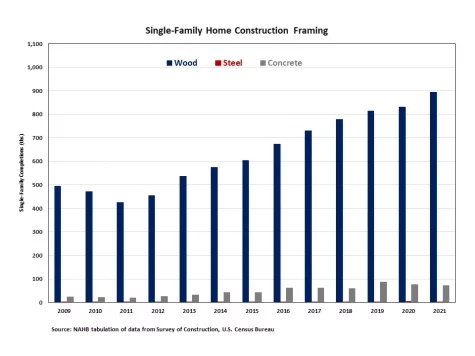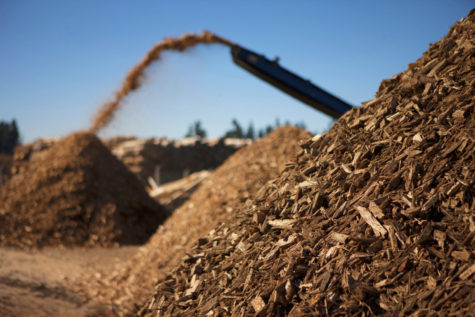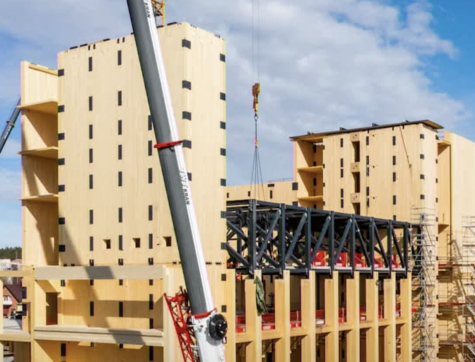HIGHLIGHTS
PROGRAM UPDATES
The AWC Deepens Understanding of Forest Management Among Sustainable Design Community Think Wood Launches Sustainable Specification Resource Center WoodWorks Promotes Wood as Viable Industrial ApplicationINDUSTRY NEWS
Wood Framing Continues to Dominate Single-Family Construction North Texas to Welcome Its First Mass Timber Office Building Inflation, Higher Interest Rates, and Supply-Chain Challenges Shake Builder Confidence University of Virginia Exposition Showcases Building With Biomaterials New Study Stresses Demand for New Apartment Units University of Georgia Experiments With Using Wood Biomass to Reduce Power Emissions Evocative, All-Timber Building Planned for Infill Project in AustinINSIGHTS ON THE COMPETITION
Energy Expert Calls Net-Zero Cement Unattainable by 2050Program Updates
The AWC Deepens Understanding of Forest Management Among Sustainable Design Community

The American Wood Council (AWC) hosted representatives from Building Transparency (home of EC3, the Embodied Carbon in Construction Calculator), Perkins&Will, and the Carbon Leadership Forum on a two-day tour of managed forests and a mill in Washington state. The aim was to enable these key sustainability stakeholders to observe active forest-management practices and discuss options for ensuring the economic and environmental viability of working forests in the future. During the tour, the group visited actively managed forests on industrial private land (Weyerhaeuser’s Vail Tree Farm), public land (Washington State Department of Natural Resources’ Tree Farm), and a small forest landowner (Wild Thyme Farm in Oakville), as well as Sierra Pacific Industries’ mill in Shelton. Conversations included job creation, environmental management, regulations, sustainability practices, new technologies, certifications, and other means to document and verify the sustainability of forest-management practices. Tour participants confirmed they gained a stronger understanding of forestry-management practices and the industry’s commitment to sustainability across the supply chain.
The AWC will continue to search for opportunities to link the sustainability and design/build communities with forests and mills and produce new education materials to foster a deeper understanding of the sustainable principles practiced by U.S. Forest managers and the softwood lumber industry.
Think Wood Launches Sustainable Specification Resource Center

Mass timber and wood products are increasingly considered for the built environment because of their carbon benefits. However, many specifiers who are more familiar with other materials remain generally unaware of wood’s comparative carbon benefits. In Think Wood–sponsored education events and on social media, the same questions are frequently asked: Why exactly is wood lower in carbon, and how do I assess a building’s carbon footprint? Are there enough harvestable trees? Will increased use of wood cause deforestation? How do I know if wood is legally and sustainably sourced?
Without answers, these questions can become barriers to building with wood. To avoid this, Think Wood launched a new Sustainable Specification Resources section on its website to tackle complex topics like sustainable forestry and building-material carbon footprints, making them easily accessible to architects, engineers, and developers. The new section contains a user-friendly, searchable repository of 70+ partner and third-party studies, videos, and presentations; newly created fact sheets; and a wood supply-chain infographic. The section aims to credibly position wood as among the best tools available to reach net-zero carbon buildings today—not in some far distant future.
Think Wood will promote the new section using targeted digital ads and email marketing. New resources from partners, including the AWC, WoodWorks, and the National Alliance of Forest Owners, can be added at any time, keeping the library relevant and up to date, and ensuring specifiers are repeat visitors.
WoodWorks Promotes Wood as Viable Industrial Application

WoodWorks has engaged with the project teams responsible for two recent mass timber warehouse projects to spread the word that wood is a viable choice for industrial and warehouse applications. WoodWorks arranged a tour of USAA Real Estate’s new warehouse in Dallas—among the first to use mass timber—for 15 invited design and construction professionals, followed by a private tour for a development firm. Afterward, a contractor let WoodWorks know that it had been approached by a tour participant considering a mass timber warehouse.
WoodWorks staff also recently toured a speculative mass timber warehouse near Denver, with the goal of promoting the project to the broader design community. The project is nearly complete and already 50% leased, asserting its commercial viability.
Industrial applications have been historically underrepresented in both light-frame and mass timber construction, despite sizable projected volume opportunity. Demonstration projects such as these are a key means to transfer knowledge, generate excitement, and ultimately result in more wood industrial buildings and warehouses.
Industry News
Wood Framing Continues to Dominate Single-Family Construction

NAHB recently reported that wood framing remained the most dominant construction method for single-family homes in 2021, despite ongoing supply-chain challenges and pricing volatility. Using Census Bureau data, NAHB analysts determined that 92% of all new homes built in 2021 were wood framed. This equated to over 895,000 new wood-framed completions, an 8% increase compared with 2020.
In 2021, there were 71,000 concrete-framed homes completed, down from 2020 and 2019 figures. Despite this yearly result, overall concrete-framed market share is still trending higher, having increased from 4% to 7% from 2011 to 2021. Steel-frame tallied just 3,000 single-family-home completions in 2021, considerably less than the 5,000 completions achieved in 2019. The majority of non-wood framing methods are located in the U.S. South, enabled by favorable residential resiliency requirements.
Read more about 2021 single-family housing completions here.
North Texas to Welcome Its First Mass Timber Office Building

Crow Holdings has announced plans to develop a seven-story, 235,000-square-foot mass timber office building as part of its larger, mixed-use The Offices at Southstone Yards development in Frisco, Texas. Designed by Duda|Paine Architects in partnership with Gensler, the building will become North Texas’ first-ever mass timber office building. The developer prioritized mass timber for its sustainability advantages, including its lower environmental footprint and higher thermal insulation.
The project will break ground this summer and is scheduled for completion in 2023. The initial office building will eventually be joined by a similar seven-story office building as well as two 10-story office buildings.
Read more about the project here.
Inflation, Higher Interest Rates, and Supply-Chain Challenges Shake Builder Confidence

Builder is reporting that the NAHB/Wells Fargo Housing Market Index (HMI), which measures builder sentiment in the market for newly built single-family homes, dropped 12 points to 55 in July, its lowest reading since May 2020. This is the seventh straight month of decline; all four regions of the United States posted declines; and all three of the HMI’s components—current sales conditions, sales expectations, and traffic of prospective buyers—trended downward. NAHB attributes the drop in builder confidence to several factors, including higher interest rates, inflation, supply-chain issues, and rising material and home-building costs, all of which have served to cool the housing market.
According to Ali Wolf, chief economist at Zonda, “After over two years of an exceptionally strong housing market, we’ve moved into an uncertain phase. Many consumers wholeheartedly would still like to buy a home, but affordability and fears of a recession are causing many to pause. Builders are trying to make sense of the quick downshift in demand and are looking for ways to strategize around what is next.”
Read more about these trends here.
University of Virginia Exposition Showcases Building With Biomaterials

The University of Virginia’s School of Architecture recently hosted a Biomaterial Building Exposition, related symposium, and gallery exhibition to demonstrate new approaches to biomaterial construction as a means of reducing wasteful building practices. The outdoor exposition featured five unique installations built using rapidly renewable, carbon-sequestering biomaterials, including wood.
A Houston-based practice, Office, built a wood structure using CNC–milled logs set amid trees. The design anticipates the structure’s weathering and eventual collapse, at which time the reclaimed lumber will be effectively returned to the forest. By thinking of the material’s life cycle through to entropy, the architects designed the structure to avoid material waste and environmental harm.
Design firm Somewhere Studio also sought to minimize construction waste by creating a structure made of suboptimal grades and species of wood retrieved from a construction site in Dallas. The company designed, cut, milled, and stitched together over 500 mixed pieces of lumber to create an enclosed wooden structure.
Read more about the exposition and see photos of the installations here.
Photo Credit: Office e.g. From Wood to Tree. Photograph by Tom Daly.
New Study Stresses Demand for New Apartment Units

A study commissioned by the National Multifamily Housing Council (NMHC) and the National Apartment Association (NAA) indicates that the United States needs upward of 266,000 new apartment homes each year—and a total 4.3 million new units by 2035—to meet demand, including for affordable housing. The study found that from 2015 to 2020, the number of affordable housing units available declined by 4.7 million nationwide.
As rental needs grow because of affordability and scarcity, the study team believes that new incentives and development approaches and fewer restrictions will be necessary to ensure adequate housing. According to NMHC president and CEO Doug Bibby, “The lack of available housing is holding our country back. Whether it is a multifamily residence, duplex, or single-family home, we need a massive supply of new for-sale and rental homes—including millions of new apartments by 2035.”
Read more about the study and its findings here.
University of Georgia Experiments With Using Wood Biomass to Reduce Power Emissions

A new study by the University of Georgia’s Warnell School of Forestry and Natural Resources, funded by a USDA McIntire-Stennis grant, suggests that replacing coal with woody biomass in Georgia’s power plants for a 50-year period could both meet power demand and cut carbon emissions.
As part of the study methodology, the research team quantified and compared three scenarios—a business-as-usual scenario of burning coal; using pulpwood as a fuel source in place of coal; and using both pulpwood and logging residues to replace coal. The third scenario—using pulpwood and logging residues—proved to be the most carbon-efficient way to generate electricity in Georgia, capable of reducing carbon emissions from power plants by 43% while not requiring major facility upgrades. This scenario would require an additional 100,000 acres of forestland to be sustainably harvested annually, which is factored into the net carbon reduction. Integrating logging residues would also enable foresters to use every part of a tree versus the current, common practice of leaving behind and burning residue.
According to associate professor and co-author Puneet Dwivedi, “Torrefied pulpwood and logging residue can be used in coal-fired power plants without making major upgrades to the plant. This makes it a great alternative to coal, especially in forest-rich southern states. . . . The use of wood-based electricity will not only reduce the carbon footprint of the state, but it will potentially create local jobs, boost forest health, increase the income of rural households, and ensure the flow of forest-based ecosystem services.”
Read more about the study findings here.
Evocative, All-Timber Building Planned for Infill Project in Austin

Swiss architecture firm Herzog & de Meuron has released designs for Sixth and Blanco, an all-timber, mixed-use, infill development that will occupy an entire city block in Austin. The new mass timber structure will emerge through and above existing storefronts and structures that date to the 1920s, will be clad in wood, and will feature sloped wooden overhangs along the sidewalk. The project is Herzog & de Meuron’s first in Texas.

Read more about the project and see renderings here.
Insights on the Competition
Energy Expert Calls Net-Zero Cement Unattainable by 2050

Writing in Forbes, contributor Steve Banker, Vice President of Supply Chain Services at ARC Advisory Group, invokes the recent analysis and commentary of scientist and policy analyst
Vaclav Smil to temper enthusiasm about the imminent prospects of net-zero cement.
In his latest book, How the World Really Works: The Science Behind How We Got Here and Where We’re Going, Smil argues that “we are a fossil-fueled civilization” and that based on his analysis of the many, varied, and vital industries that rely on carbon-based fossil fuels and materials, it will take anywhere from several decades to over a century to reduce our dependence on these fuels.
For example, Smil is doubtful that the cement industry can eliminate its dependence on fossil fuels and stop being a significant contributor to CO2 by 2050, which is the target adopted by many in the concrete industry. Achieving net-zero concrete will require large-scale and cost-effective carbon capture and storage. While some firms, including Holcim, are currently piloting carbon-capture projects, Smil believes mass-scale carbon capture “would necessitate the creation of an entirely new gas-capture-transportation-storage industry that every year would have to handle 1.3–2.4 times the volume of current U.S. crude production, an industry that took more than 160 years and trillions of dollars to build.”
Industry Resources
FEA’s Housing Dashboard
This housing dashboard is provided compliments of Forest Economic Advisors (FEA). View the August Dashboard
Virginia Tech’s Monthly Housing Report
This monthly housing commentary report is a free service of Virginia Tech and is intended to help one gauge future business activity in the U.S. housing market.
June 2022 Reports (released in August 2022)
Part A: August Housing Commentary
Part B: August Economic Conditions



